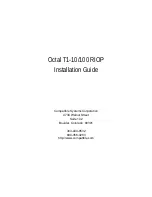
Chapter 2 - Quickstart Instructions
4
Chapter 2 - Quickstart Instructions
This Quickstart chapter briefly discusses the major parameters that must be set in order to use
the Octal T1-10/100 RIOP as part of your VSR multigigabit switching router.
Detailed information on the meaning of the router’s parameters is provided in the Compa-
tiView Management Software Reference Guide and the Text-Based Configuration and
Command Line Management Reference Guide. You should use this list as a starting point to
look up more specific information in the other documents.
If you need more general information on IP, IPX, AppleTalk or wide area protocols, see the
Appendices in the CompatiView Management Software Reference Guide.
There are a number of parameter settings which are optional, in the sense that they are not
required for all installations. These settings are not covered in this chapter.
In this chapter:
CV = CompatiView
TB = Text-Based Configuration
In order to successfully connect to an Internet Service Provider (ISP), you must use router
configuration parameters which will be provided by the technical staff of the ISP. These
parameters must include all IP addresses, WAN settings and any applicable authorization
routines. Please check with your ISP before changing the configuration of your Octal T1-10/
100 RIOP.
v
Note:
This Quickstart does not include information on setting up packet filters for using the
router as a Firewall. See the CompatiView Management Software Reference Guide or Text-
Based Configuration and Command Line Management Reference Guide regarding IP
packet filters for more information.
Ethernet Interface Configuration
Ethernet interfaces are considerably easier to set up than wide area interfaces since there are
fewer choices that need to be made regarding communications protocols and parameters. We
recommend that you begin by configuring any Ethernet interface parameters before proceeding
to configure WAN interface parameters.
IP Protocol
Required for IP
These parameters set the basic address characteristics of the interface. They provide enough
information for another IP node to find the interface (such as a Telnet client), but not enough
information for routing to take place.
•
IP address
•
IP subnet mask
•
IP broadcast address
CV: Use the TCP/IP Routing: Ethernet 0 Dialog Box to set these parameters.
TB: Use the configure command and set the IPAddress, SubnetMask, and IPBroadcast
keywords in the IP Ethernet 0 section.
Suggested for IP
These parameters help supply information about the segment that the interface is connected to.
With this information, routing can take place.
•
Set IP RIP 1, IP RIP 2 or OSPF (Open Shortest Path First)




































